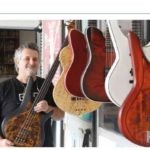Interview with Michael Tauber-Atelier der Tonkust.
Do the features of components of the guitar circuit, we are talking about cables, pots, capacitor, shielding, circuit layout, affects the tone of the instrument?
Yes. If you make the same circuit with two different set of components, pots from different makers, capacitors of the same capacitance but of differing types, cables with different gauges or different insulation quality, components with different layouts and so on, there will always be a difference in tone quality. The problem is judging the difference. We have to classify the sensation to be able to make use of it.
You can look for where this difference can come from, but the measured features could be just the same and still sound different, because the difference could be in something you may not measure or the tolerances may not be accurate enough, etc. The tone of a circuit should be an empirical research discovering the properties of each feature, then reversing the process and being able to make use of the features to tailor the sound to the needs of the player.
There are general physic theories, there are electricity rules, there are also guidelines on the guitar circuit electrical circuits, but then there is just empirical knowledge that will let you notice the evidence, like a certain type of capacitor with certain tone features will create a rule that lets this feature work well for a certain project.
Which is the electric feature that you consider to be the one that gives and define the tone of a component?
The sound of an electric instrument is represented by an electrical signal created by sensors which transform mechanical vibrations of the instrument into electric current. These signals are further processed by controls and switches to modify the signal in a desired fashion. All of these elements have specific functions in shaping the signal, but real life properties also affect the audible result.
Dielectric absorption is how the electric fields are absorbed by the surrounding materials. This is mostly non-linear, which means it could add harmonics and influence the electric behavior of the circuit or the flow of the electric current. It affects everything that the current passes through, from pc board to cables, resistors, capacitors, etc. And it is something not visible or written on schematics. You cannot readily see how the cables are insulated, if is there a shield on the pickups, how the cables are routed, and many other detail. This is not written in the guitar circuit diagram but it all affects the tone.
Absorption is a complex subject. Another underestimated effect is the skin effect. It is connected to composition and diameter of the conductor and the frequency you want to conduct, and it is also affected by the nature of the physical materials. With alternate frequencies the surface conducting current is much lower than the full cable section. Then, as it happens in alternate current, any charge and discharge of a component it gives towards the insulation loses heat. This can mean changes in harmonics due to non-linearity behavior of materials, different response on different frequencies, which especially true with plastic components.
Absorption linkage is represented by a resistance, parallel or to ground, and can be in the order of kilo-mega or giga or tera ohms. Skin effects can be represented by serial resistance of a fraction of ohms to even kilo-ohms. Shielding is a parallel capacity to all conductors. Imagine it like being the two plates of a Capacitor. The distance between the materials, the material of which the shield is composed, the dimensions, all of these affect the value of a capacitor, and that can represent the effects of it. The charge and discharge of the two plates produce complex non-linear harmonic and dynamic influences.
What about the condenser myth ?
The condenser is always affecting the circuit in some way, as it is an element always connected to load. So it can give an effect. How and which is a subject to be determined through experimentation.
How can we code all these effects tone-wise?
If we write down all these effects, we can think of completing the original schematic of our circuit with resistances, inductances and capacitances representing the elements, the materials, the effects. This is mostly ideal, as all these effects are very complex and difficult to determine or measure correctly.
Next is to design and/or to compose the circuitry as carefully as you choose all the other components of an instrument, like woods, glue, finishes and the like. One practical way could be empiric, noticing the differences or the effects of different solutions, and note them, to create experience and mastering the variations. But these elements are the reason why different circuits layout or materials will give different tones.
As for guitar building, it is a process of mastering all of the elements to get a desired result. The same is true of approaching the electrical circuit realization: knowing the effects of different parts, solutions and layout. So it is not just the quality of materials the achieves the result, but knowing how they all work together to create the ultimate sound of the instrument.


















 Italiano
Italiano


